Organizational Culture: An In-Depth Literature Review Essay
VerifiedAdded on 2023/06/08
|13
|3449
|84
Essay
AI Summary
This essay delves into the multifaceted concept of organizational culture, examining its significance in contemporary business environments. The essay begins with an executive summary and table of contents, followed by an introduction that establishes the importance of organizational culture in shaping employee behavior and fostering long-term organizational success. The core of the essay is a comprehensive literature review, which synthesizes findings from nine articles on organizational culture. Each article is summarized and analyzed, exploring themes such as the impact of strong versus weak cultures on employee motivation, the role of executive leadership in shaping culture, and the relationship between culture and performance. Diagrams are included to illustrate key concepts. The essay then offers recommendations for organizations seeking to cultivate a positive and effective culture and concludes with a synthesis of the key insights from the literature review. References are provided to support the analysis.

Running Head: ORGANISATIONAL BEHAVIOUR 0
Organizational Behavior
8/30/2018
Organizational Behavior
8/30/2018
Paraphrase This Document
Need a fresh take? Get an instant paraphrase of this document with our AI Paraphraser

ORGANISATIONAL BEHAVIOUR 1
Executive Summary
The concept of the organisational culture has evolved over past decades and has been
emerging continuously in the contemporary organisations. As the organisations in today’s
scenario are increasingly becoming competitive and thriving to attain long-term success and
growth in the future; maintaining a strong organisation culture is essential. Organisational
culture is wide and popular phenomenon in the field of organisational behaviour. The culture
of an organisation affects the productivity, turnover, and organisational commitment in an
organisational setup. Cultural values, norms, and beliefs in every organisation differ with
another, and tend to establish different set of rules, policies, and strategies to achieve
organisational objectives.
Executive Summary
The concept of the organisational culture has evolved over past decades and has been
emerging continuously in the contemporary organisations. As the organisations in today’s
scenario are increasingly becoming competitive and thriving to attain long-term success and
growth in the future; maintaining a strong organisation culture is essential. Organisational
culture is wide and popular phenomenon in the field of organisational behaviour. The culture
of an organisation affects the productivity, turnover, and organisational commitment in an
organisational setup. Cultural values, norms, and beliefs in every organisation differ with
another, and tend to establish different set of rules, policies, and strategies to achieve
organisational objectives.
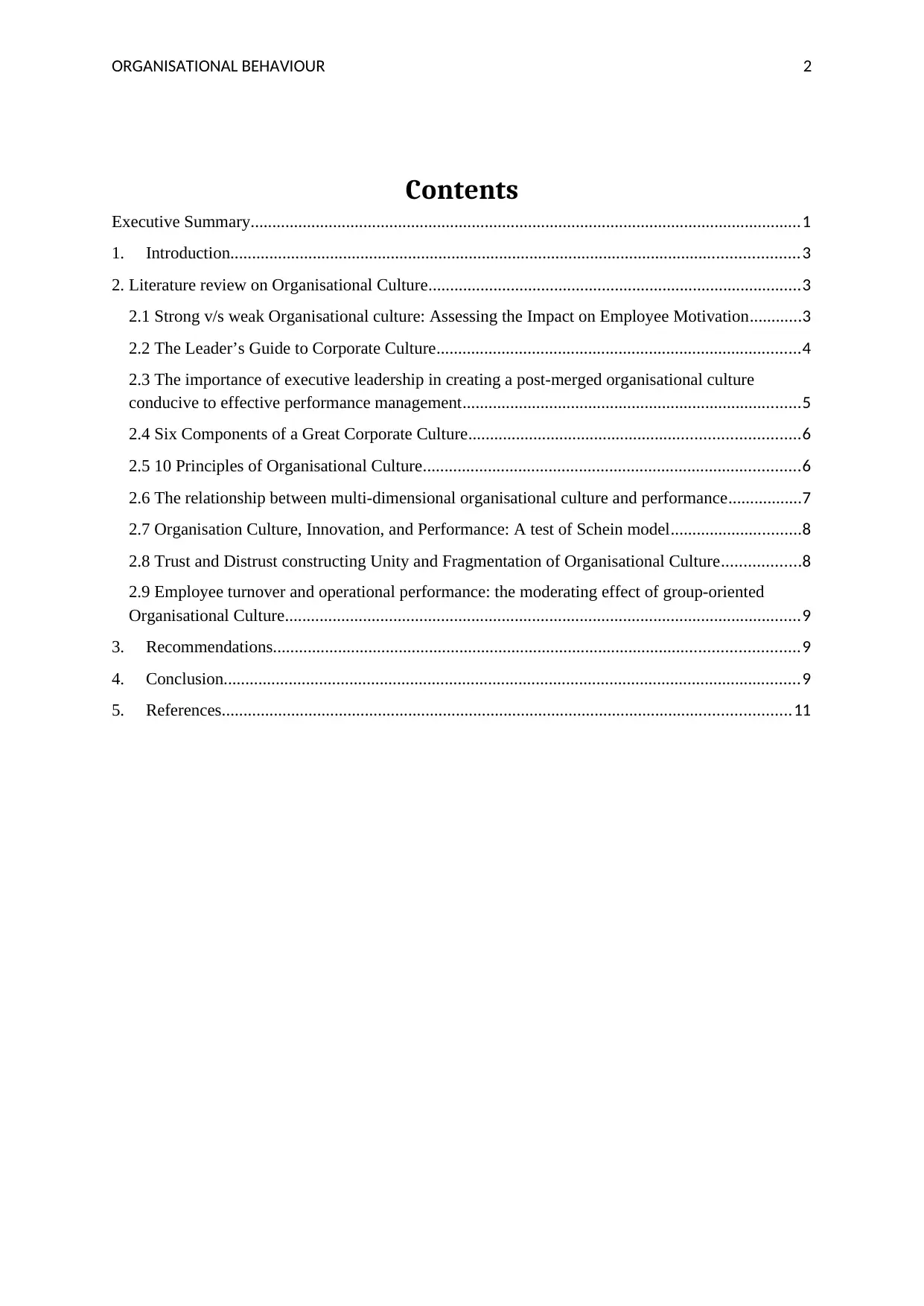
ORGANISATIONAL BEHAVIOUR 2
Contents
Executive Summary...............................................................................................................................1
1. Introduction...................................................................................................................................3
2. Literature review on Organisational Culture......................................................................................3
2.1 Strong v/s weak Organisational culture: Assessing the Impact on Employee Motivation............3
2.2 The Leader’s Guide to Corporate Culture....................................................................................4
2.3 The importance of executive leadership in creating a post-merged organisational culture
conducive to effective performance management..............................................................................5
2.4 Six Components of a Great Corporate Culture............................................................................6
2.5 10 Principles of Organisational Culture.......................................................................................6
2.6 The relationship between multi-dimensional organisational culture and performance.................7
2.7 Organisation Culture, Innovation, and Performance: A test of Schein model..............................8
2.8 Trust and Distrust constructing Unity and Fragmentation of Organisational Culture..................8
2.9 Employee turnover and operational performance: the moderating effect of group-oriented
Organisational Culture.......................................................................................................................9
3. Recommendations.........................................................................................................................9
4. Conclusion.....................................................................................................................................9
5. References...................................................................................................................................11
Contents
Executive Summary...............................................................................................................................1
1. Introduction...................................................................................................................................3
2. Literature review on Organisational Culture......................................................................................3
2.1 Strong v/s weak Organisational culture: Assessing the Impact on Employee Motivation............3
2.2 The Leader’s Guide to Corporate Culture....................................................................................4
2.3 The importance of executive leadership in creating a post-merged organisational culture
conducive to effective performance management..............................................................................5
2.4 Six Components of a Great Corporate Culture............................................................................6
2.5 10 Principles of Organisational Culture.......................................................................................6
2.6 The relationship between multi-dimensional organisational culture and performance.................7
2.7 Organisation Culture, Innovation, and Performance: A test of Schein model..............................8
2.8 Trust and Distrust constructing Unity and Fragmentation of Organisational Culture..................8
2.9 Employee turnover and operational performance: the moderating effect of group-oriented
Organisational Culture.......................................................................................................................9
3. Recommendations.........................................................................................................................9
4. Conclusion.....................................................................................................................................9
5. References...................................................................................................................................11
⊘ This is a preview!⊘
Do you want full access?
Subscribe today to unlock all pages.

Trusted by 1+ million students worldwide
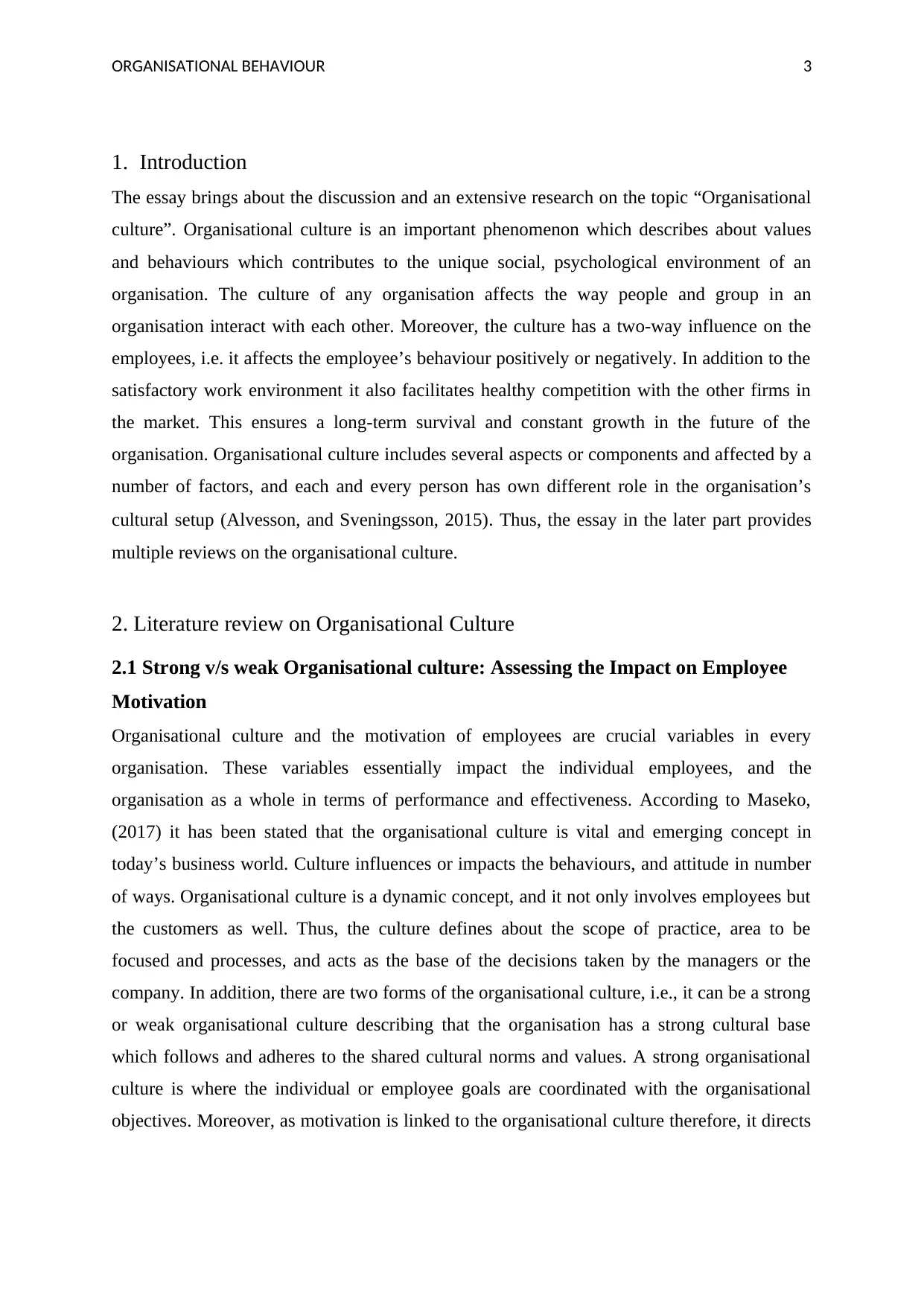
ORGANISATIONAL BEHAVIOUR 3
1. Introduction
The essay brings about the discussion and an extensive research on the topic “Organisational
culture”. Organisational culture is an important phenomenon which describes about values
and behaviours which contributes to the unique social, psychological environment of an
organisation. The culture of any organisation affects the way people and group in an
organisation interact with each other. Moreover, the culture has a two-way influence on the
employees, i.e. it affects the employee’s behaviour positively or negatively. In addition to the
satisfactory work environment it also facilitates healthy competition with the other firms in
the market. This ensures a long-term survival and constant growth in the future of the
organisation. Organisational culture includes several aspects or components and affected by a
number of factors, and each and every person has own different role in the organisation’s
cultural setup (Alvesson, and Sveningsson, 2015). Thus, the essay in the later part provides
multiple reviews on the organisational culture.
2. Literature review on Organisational Culture
2.1 Strong v/s weak Organisational culture: Assessing the Impact on Employee
Motivation
Organisational culture and the motivation of employees are crucial variables in every
organisation. These variables essentially impact the individual employees, and the
organisation as a whole in terms of performance and effectiveness. According to Maseko,
(2017) it has been stated that the organisational culture is vital and emerging concept in
today’s business world. Culture influences or impacts the behaviours, and attitude in number
of ways. Organisational culture is a dynamic concept, and it not only involves employees but
the customers as well. Thus, the culture defines about the scope of practice, area to be
focused and processes, and acts as the base of the decisions taken by the managers or the
company. In addition, there are two forms of the organisational culture, i.e., it can be a strong
or weak organisational culture describing that the organisation has a strong cultural base
which follows and adheres to the shared cultural norms and values. A strong organisational
culture is where the individual or employee goals are coordinated with the organisational
objectives. Moreover, as motivation is linked to the organisational culture therefore, it directs
1. Introduction
The essay brings about the discussion and an extensive research on the topic “Organisational
culture”. Organisational culture is an important phenomenon which describes about values
and behaviours which contributes to the unique social, psychological environment of an
organisation. The culture of any organisation affects the way people and group in an
organisation interact with each other. Moreover, the culture has a two-way influence on the
employees, i.e. it affects the employee’s behaviour positively or negatively. In addition to the
satisfactory work environment it also facilitates healthy competition with the other firms in
the market. This ensures a long-term survival and constant growth in the future of the
organisation. Organisational culture includes several aspects or components and affected by a
number of factors, and each and every person has own different role in the organisation’s
cultural setup (Alvesson, and Sveningsson, 2015). Thus, the essay in the later part provides
multiple reviews on the organisational culture.
2. Literature review on Organisational Culture
2.1 Strong v/s weak Organisational culture: Assessing the Impact on Employee
Motivation
Organisational culture and the motivation of employees are crucial variables in every
organisation. These variables essentially impact the individual employees, and the
organisation as a whole in terms of performance and effectiveness. According to Maseko,
(2017) it has been stated that the organisational culture is vital and emerging concept in
today’s business world. Culture influences or impacts the behaviours, and attitude in number
of ways. Organisational culture is a dynamic concept, and it not only involves employees but
the customers as well. Thus, the culture defines about the scope of practice, area to be
focused and processes, and acts as the base of the decisions taken by the managers or the
company. In addition, there are two forms of the organisational culture, i.e., it can be a strong
or weak organisational culture describing that the organisation has a strong cultural base
which follows and adheres to the shared cultural norms and values. A strong organisational
culture is where the individual or employee goals are coordinated with the organisational
objectives. Moreover, as motivation is linked to the organisational culture therefore, it directs
Paraphrase This Document
Need a fresh take? Get an instant paraphrase of this document with our AI Paraphraser
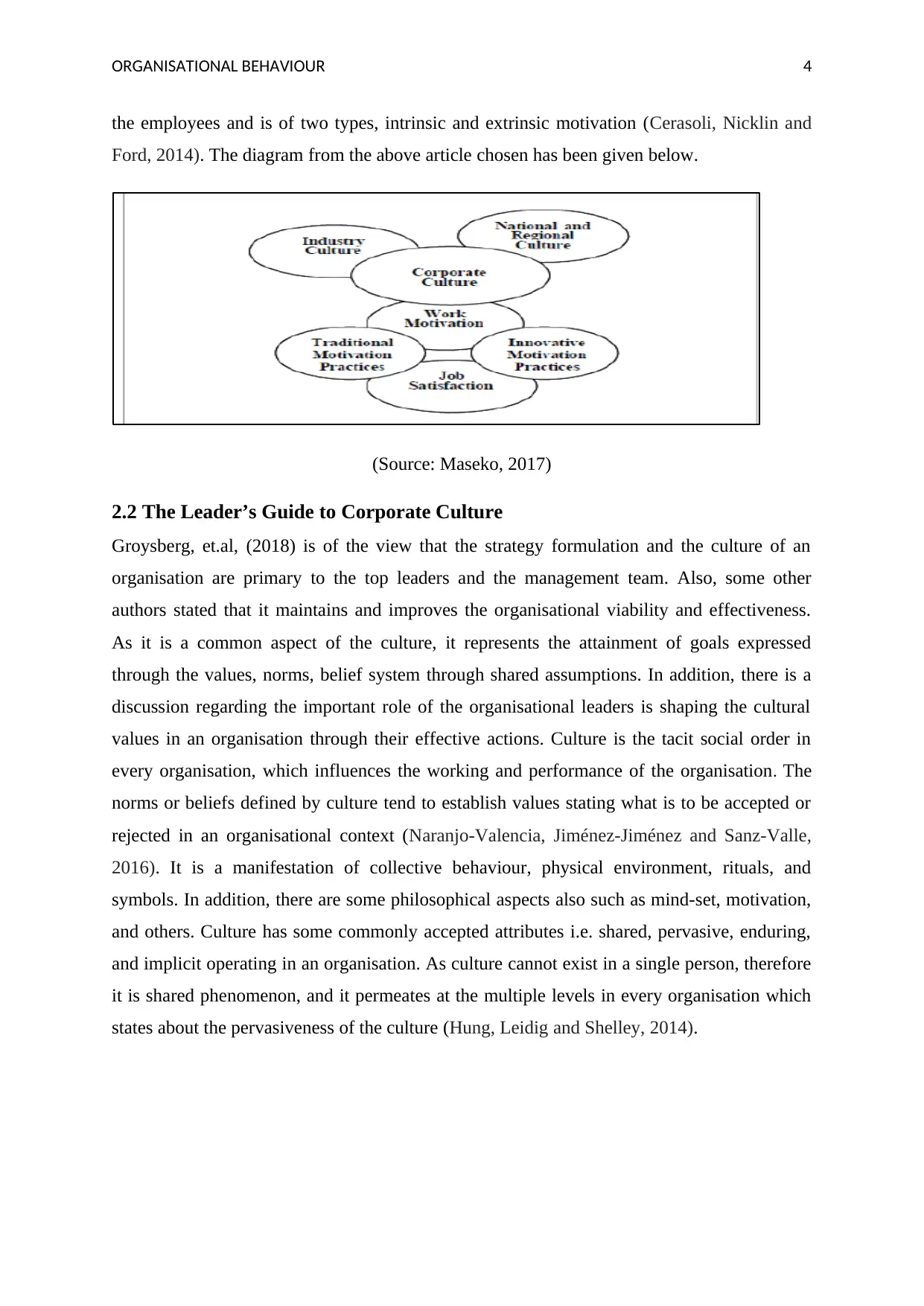
ORGANISATIONAL BEHAVIOUR 4
the employees and is of two types, intrinsic and extrinsic motivation (Cerasoli, Nicklin and
Ford, 2014). The diagram from the above article chosen has been given below.
(Source: Maseko, 2017)
2.2 The Leader’s Guide to Corporate Culture
Groysberg, et.al, (2018) is of the view that the strategy formulation and the culture of an
organisation are primary to the top leaders and the management team. Also, some other
authors stated that it maintains and improves the organisational viability and effectiveness.
As it is a common aspect of the culture, it represents the attainment of goals expressed
through the values, norms, belief system through shared assumptions. In addition, there is a
discussion regarding the important role of the organisational leaders is shaping the cultural
values in an organisation through their effective actions. Culture is the tacit social order in
every organisation, which influences the working and performance of the organisation. The
norms or beliefs defined by culture tend to establish values stating what is to be accepted or
rejected in an organisational context (Naranjo-Valencia, Jiménez-Jiménez and Sanz-Valle,
2016). It is a manifestation of collective behaviour, physical environment, rituals, and
symbols. In addition, there are some philosophical aspects also such as mind-set, motivation,
and others. Culture has some commonly accepted attributes i.e. shared, pervasive, enduring,
and implicit operating in an organisation. As culture cannot exist in a single person, therefore
it is shared phenomenon, and it permeates at the multiple levels in every organisation which
states about the pervasiveness of the culture (Hung, Leidig and Shelley, 2014).
the employees and is of two types, intrinsic and extrinsic motivation (Cerasoli, Nicklin and
Ford, 2014). The diagram from the above article chosen has been given below.
(Source: Maseko, 2017)
2.2 The Leader’s Guide to Corporate Culture
Groysberg, et.al, (2018) is of the view that the strategy formulation and the culture of an
organisation are primary to the top leaders and the management team. Also, some other
authors stated that it maintains and improves the organisational viability and effectiveness.
As it is a common aspect of the culture, it represents the attainment of goals expressed
through the values, norms, belief system through shared assumptions. In addition, there is a
discussion regarding the important role of the organisational leaders is shaping the cultural
values in an organisation through their effective actions. Culture is the tacit social order in
every organisation, which influences the working and performance of the organisation. The
norms or beliefs defined by culture tend to establish values stating what is to be accepted or
rejected in an organisational context (Naranjo-Valencia, Jiménez-Jiménez and Sanz-Valle,
2016). It is a manifestation of collective behaviour, physical environment, rituals, and
symbols. In addition, there are some philosophical aspects also such as mind-set, motivation,
and others. Culture has some commonly accepted attributes i.e. shared, pervasive, enduring,
and implicit operating in an organisation. As culture cannot exist in a single person, therefore
it is shared phenomenon, and it permeates at the multiple levels in every organisation which
states about the pervasiveness of the culture (Hung, Leidig and Shelley, 2014).
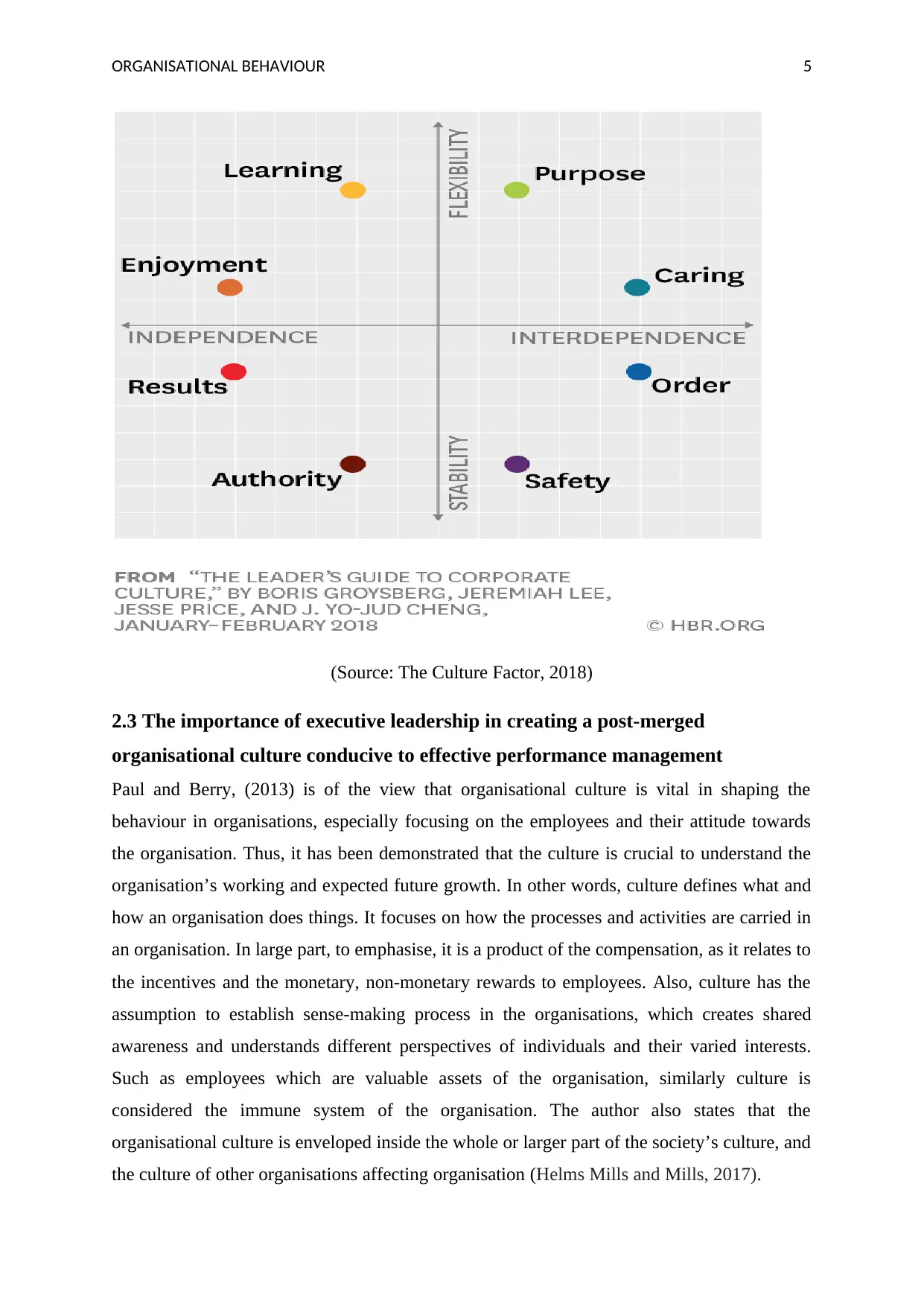
ORGANISATIONAL BEHAVIOUR 5
(Source: The Culture Factor, 2018)
2.3 The importance of executive leadership in creating a post-merged
organisational culture conducive to effective performance management
Paul and Berry, (2013) is of the view that organisational culture is vital in shaping the
behaviour in organisations, especially focusing on the employees and their attitude towards
the organisation. Thus, it has been demonstrated that the culture is crucial to understand the
organisation’s working and expected future growth. In other words, culture defines what and
how an organisation does things. It focuses on how the processes and activities are carried in
an organisation. In large part, to emphasise, it is a product of the compensation, as it relates to
the incentives and the monetary, non-monetary rewards to employees. Also, culture has the
assumption to establish sense-making process in the organisations, which creates shared
awareness and understands different perspectives of individuals and their varied interests.
Such as employees which are valuable assets of the organisation, similarly culture is
considered the immune system of the organisation. The author also states that the
organisational culture is enveloped inside the whole or larger part of the society’s culture, and
the culture of other organisations affecting organisation (Helms Mills and Mills, 2017).
(Source: The Culture Factor, 2018)
2.3 The importance of executive leadership in creating a post-merged
organisational culture conducive to effective performance management
Paul and Berry, (2013) is of the view that organisational culture is vital in shaping the
behaviour in organisations, especially focusing on the employees and their attitude towards
the organisation. Thus, it has been demonstrated that the culture is crucial to understand the
organisation’s working and expected future growth. In other words, culture defines what and
how an organisation does things. It focuses on how the processes and activities are carried in
an organisation. In large part, to emphasise, it is a product of the compensation, as it relates to
the incentives and the monetary, non-monetary rewards to employees. Also, culture has the
assumption to establish sense-making process in the organisations, which creates shared
awareness and understands different perspectives of individuals and their varied interests.
Such as employees which are valuable assets of the organisation, similarly culture is
considered the immune system of the organisation. The author also states that the
organisational culture is enveloped inside the whole or larger part of the society’s culture, and
the culture of other organisations affecting organisation (Helms Mills and Mills, 2017).
⊘ This is a preview!⊘
Do you want full access?
Subscribe today to unlock all pages.

Trusted by 1+ million students worldwide

ORGANISATIONAL BEHAVIOUR 6
2.4 Six Components of a Great Corporate Culture
According to the Coleman, (2013) it has understood that every organisation and the culture
within the organisations is unique and there are at least 6 major component of a great
organisation culture. These components are the steps to enhance the capability and make a
difference and sustain a competitive position in the marketplace. The components consist of
the terms such as vision, values, practices, people, and place. Vision is the first and foremost
component, which forms the basis of any organisation’s culture. The vision of the company
guides a company’s values and states about the purpose of those values. Good vision
statement of an organisation improves the relations of the company with the customer, and
stakeholders. The other key component of the culture is ‘values’, which is the core of the
culture. Vision states the purpose and values define guidelines on the behaviour and mind-set
required to achieve that vision. Practices is the another component which are determined after
defining the purpose and the values and people are valuable as none of the organisation can
build a comprehensible culture, without their employees.
2.5 10 Principles of Organisational Culture
Katzenbach, et.al, (2016) is of the view, that a company can tap the advantage naturally when
they focus on improving the behaviour, enlisting the leaders, and enhancing the motivation
level of employees. Thus, organisational culture is an important feature of an organisation
and the people working in it. However, it is a separate entity which evolves through the
gradual shifts in the leadership, strategy and other things. Also, culture of an organisation is
constructed through the interactive, emotional responses and the repetitive habits and
behaviour of employees; thus it cannot be acquired from other organisation. The culture of an
organisation cannot be wholly changed but some of the aspects could be modified as per the
changing environmental needs. Thus, it forms 10 principles of the organisational culture,
these are mentioned below. The diagram below mentions 10 principles of the organisational
culture, which follows an effective approach towards the attainment of goals and objectives.
2.4 Six Components of a Great Corporate Culture
According to the Coleman, (2013) it has understood that every organisation and the culture
within the organisations is unique and there are at least 6 major component of a great
organisation culture. These components are the steps to enhance the capability and make a
difference and sustain a competitive position in the marketplace. The components consist of
the terms such as vision, values, practices, people, and place. Vision is the first and foremost
component, which forms the basis of any organisation’s culture. The vision of the company
guides a company’s values and states about the purpose of those values. Good vision
statement of an organisation improves the relations of the company with the customer, and
stakeholders. The other key component of the culture is ‘values’, which is the core of the
culture. Vision states the purpose and values define guidelines on the behaviour and mind-set
required to achieve that vision. Practices is the another component which are determined after
defining the purpose and the values and people are valuable as none of the organisation can
build a comprehensible culture, without their employees.
2.5 10 Principles of Organisational Culture
Katzenbach, et.al, (2016) is of the view, that a company can tap the advantage naturally when
they focus on improving the behaviour, enlisting the leaders, and enhancing the motivation
level of employees. Thus, organisational culture is an important feature of an organisation
and the people working in it. However, it is a separate entity which evolves through the
gradual shifts in the leadership, strategy and other things. Also, culture of an organisation is
constructed through the interactive, emotional responses and the repetitive habits and
behaviour of employees; thus it cannot be acquired from other organisation. The culture of an
organisation cannot be wholly changed but some of the aspects could be modified as per the
changing environmental needs. Thus, it forms 10 principles of the organisational culture,
these are mentioned below. The diagram below mentions 10 principles of the organisational
culture, which follows an effective approach towards the attainment of goals and objectives.
Paraphrase This Document
Need a fresh take? Get an instant paraphrase of this document with our AI Paraphraser

ORGANISATIONAL BEHAVIOUR 7
(Source: Strategy business, 2016)
There are three dimensions of the corporate culture which affect the alignment i.e. symbolic
reminders, keystone behaviours, and the mind-set of the individuals. Amongst these
dimensions, behaviour is the most important that brings real change in the organisation. Thus,
culture is a challenging and a multi-dimensional concept in an organisational context.
2.6 The relationship between multi-dimensional organisational culture and
performance
Prajogo and McDermott, (2011) was of the view that there is an established relationship
between the multidimensional organisational culture and performance of the organisation.
There are four cultural dimensions based upon the CVF (Competing Values Framework)
model which include group, developmental, hierarchal, and rational dimensions. These
dimensions were measured against the four types of performance, quality of the product,
process control, product, and the process innovation. Also, it has been demonstrated that
those organisations that represents the attributes of a strong organisational culture, become
effective in enhancing their financial stability and performance. Culture includes some
common values, beliefs, and symbols in an organisation shared by the members towards
achievement of their goals. Culture therefore, is considered to be an explanatory variable
which although consist of some common features but differs with the nature of organisation.
In other words, it can be stated that the culture in an organisation serves as a potential
towards gaining a competitive advantage amongst other firms. Ultimately, combining all the
(Source: Strategy business, 2016)
There are three dimensions of the corporate culture which affect the alignment i.e. symbolic
reminders, keystone behaviours, and the mind-set of the individuals. Amongst these
dimensions, behaviour is the most important that brings real change in the organisation. Thus,
culture is a challenging and a multi-dimensional concept in an organisational context.
2.6 The relationship between multi-dimensional organisational culture and
performance
Prajogo and McDermott, (2011) was of the view that there is an established relationship
between the multidimensional organisational culture and performance of the organisation.
There are four cultural dimensions based upon the CVF (Competing Values Framework)
model which include group, developmental, hierarchal, and rational dimensions. These
dimensions were measured against the four types of performance, quality of the product,
process control, product, and the process innovation. Also, it has been demonstrated that
those organisations that represents the attributes of a strong organisational culture, become
effective in enhancing their financial stability and performance. Culture includes some
common values, beliefs, and symbols in an organisation shared by the members towards
achievement of their goals. Culture therefore, is considered to be an explanatory variable
which although consist of some common features but differs with the nature of organisation.
In other words, it can be stated that the culture in an organisation serves as a potential
towards gaining a competitive advantage amongst other firms. Ultimately, combining all the
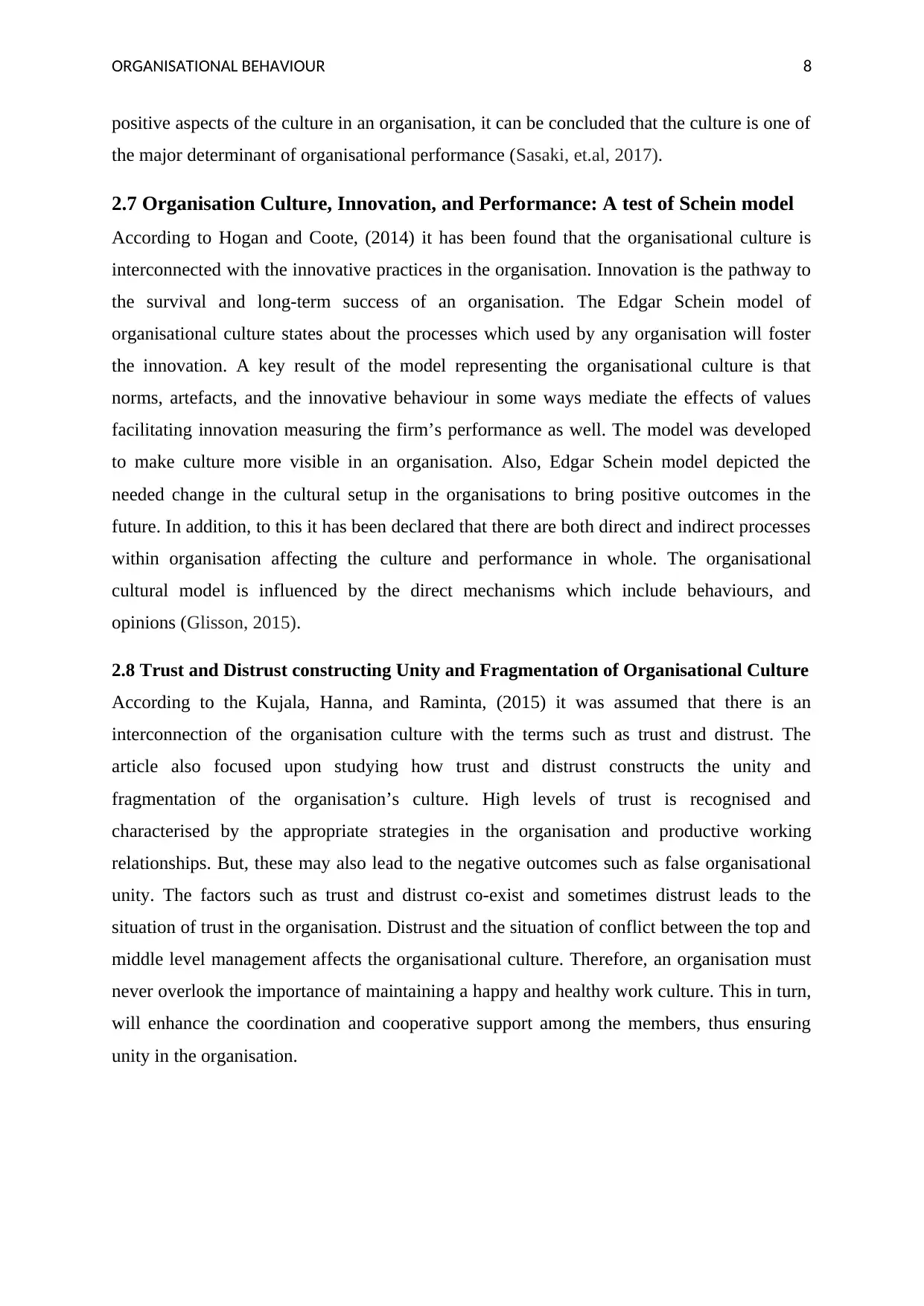
ORGANISATIONAL BEHAVIOUR 8
positive aspects of the culture in an organisation, it can be concluded that the culture is one of
the major determinant of organisational performance (Sasaki, et.al, 2017).
2.7 Organisation Culture, Innovation, and Performance: A test of Schein model
According to Hogan and Coote, (2014) it has been found that the organisational culture is
interconnected with the innovative practices in the organisation. Innovation is the pathway to
the survival and long-term success of an organisation. The Edgar Schein model of
organisational culture states about the processes which used by any organisation will foster
the innovation. A key result of the model representing the organisational culture is that
norms, artefacts, and the innovative behaviour in some ways mediate the effects of values
facilitating innovation measuring the firm’s performance as well. The model was developed
to make culture more visible in an organisation. Also, Edgar Schein model depicted the
needed change in the cultural setup in the organisations to bring positive outcomes in the
future. In addition, to this it has been declared that there are both direct and indirect processes
within organisation affecting the culture and performance in whole. The organisational
cultural model is influenced by the direct mechanisms which include behaviours, and
opinions (Glisson, 2015).
2.8 Trust and Distrust constructing Unity and Fragmentation of Organisational Culture
According to the Kujala, Hanna, and Raminta, (2015) it was assumed that there is an
interconnection of the organisation culture with the terms such as trust and distrust. The
article also focused upon studying how trust and distrust constructs the unity and
fragmentation of the organisation’s culture. High levels of trust is recognised and
characterised by the appropriate strategies in the organisation and productive working
relationships. But, these may also lead to the negative outcomes such as false organisational
unity. The factors such as trust and distrust co-exist and sometimes distrust leads to the
situation of trust in the organisation. Distrust and the situation of conflict between the top and
middle level management affects the organisational culture. Therefore, an organisation must
never overlook the importance of maintaining a happy and healthy work culture. This in turn,
will enhance the coordination and cooperative support among the members, thus ensuring
unity in the organisation.
positive aspects of the culture in an organisation, it can be concluded that the culture is one of
the major determinant of organisational performance (Sasaki, et.al, 2017).
2.7 Organisation Culture, Innovation, and Performance: A test of Schein model
According to Hogan and Coote, (2014) it has been found that the organisational culture is
interconnected with the innovative practices in the organisation. Innovation is the pathway to
the survival and long-term success of an organisation. The Edgar Schein model of
organisational culture states about the processes which used by any organisation will foster
the innovation. A key result of the model representing the organisational culture is that
norms, artefacts, and the innovative behaviour in some ways mediate the effects of values
facilitating innovation measuring the firm’s performance as well. The model was developed
to make culture more visible in an organisation. Also, Edgar Schein model depicted the
needed change in the cultural setup in the organisations to bring positive outcomes in the
future. In addition, to this it has been declared that there are both direct and indirect processes
within organisation affecting the culture and performance in whole. The organisational
cultural model is influenced by the direct mechanisms which include behaviours, and
opinions (Glisson, 2015).
2.8 Trust and Distrust constructing Unity and Fragmentation of Organisational Culture
According to the Kujala, Hanna, and Raminta, (2015) it was assumed that there is an
interconnection of the organisation culture with the terms such as trust and distrust. The
article also focused upon studying how trust and distrust constructs the unity and
fragmentation of the organisation’s culture. High levels of trust is recognised and
characterised by the appropriate strategies in the organisation and productive working
relationships. But, these may also lead to the negative outcomes such as false organisational
unity. The factors such as trust and distrust co-exist and sometimes distrust leads to the
situation of trust in the organisation. Distrust and the situation of conflict between the top and
middle level management affects the organisational culture. Therefore, an organisation must
never overlook the importance of maintaining a happy and healthy work culture. This in turn,
will enhance the coordination and cooperative support among the members, thus ensuring
unity in the organisation.
⊘ This is a preview!⊘
Do you want full access?
Subscribe today to unlock all pages.

Trusted by 1+ million students worldwide
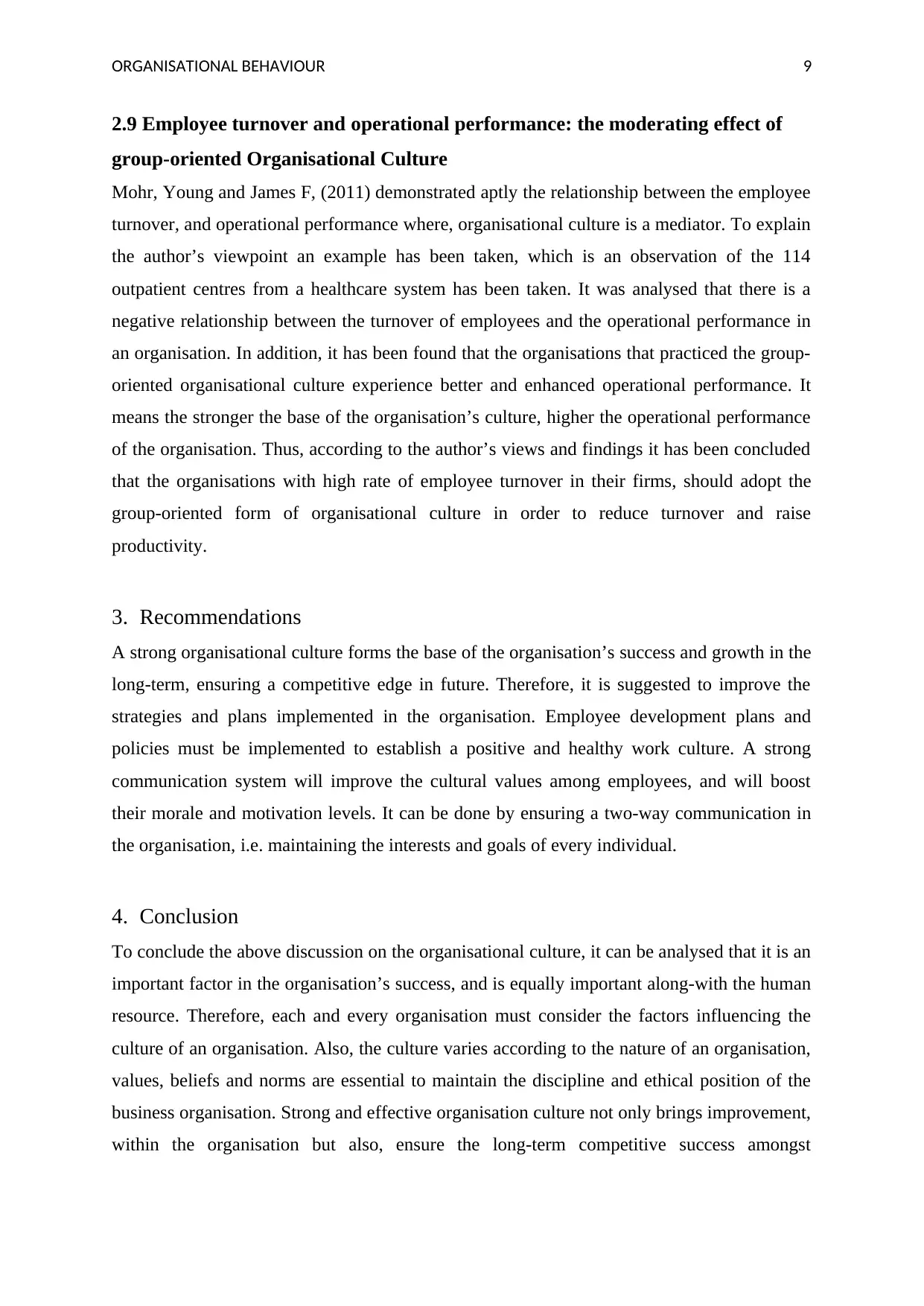
ORGANISATIONAL BEHAVIOUR 9
2.9 Employee turnover and operational performance: the moderating effect of
group-oriented Organisational Culture
Mohr, Young and James F, (2011) demonstrated aptly the relationship between the employee
turnover, and operational performance where, organisational culture is a mediator. To explain
the author’s viewpoint an example has been taken, which is an observation of the 114
outpatient centres from a healthcare system has been taken. It was analysed that there is a
negative relationship between the turnover of employees and the operational performance in
an organisation. In addition, it has been found that the organisations that practiced the group-
oriented organisational culture experience better and enhanced operational performance. It
means the stronger the base of the organisation’s culture, higher the operational performance
of the organisation. Thus, according to the author’s views and findings it has been concluded
that the organisations with high rate of employee turnover in their firms, should adopt the
group-oriented form of organisational culture in order to reduce turnover and raise
productivity.
3. Recommendations
A strong organisational culture forms the base of the organisation’s success and growth in the
long-term, ensuring a competitive edge in future. Therefore, it is suggested to improve the
strategies and plans implemented in the organisation. Employee development plans and
policies must be implemented to establish a positive and healthy work culture. A strong
communication system will improve the cultural values among employees, and will boost
their morale and motivation levels. It can be done by ensuring a two-way communication in
the organisation, i.e. maintaining the interests and goals of every individual.
4. Conclusion
To conclude the above discussion on the organisational culture, it can be analysed that it is an
important factor in the organisation’s success, and is equally important along-with the human
resource. Therefore, each and every organisation must consider the factors influencing the
culture of an organisation. Also, the culture varies according to the nature of an organisation,
values, beliefs and norms are essential to maintain the discipline and ethical position of the
business organisation. Strong and effective organisation culture not only brings improvement,
within the organisation but also, ensure the long-term competitive success amongst
2.9 Employee turnover and operational performance: the moderating effect of
group-oriented Organisational Culture
Mohr, Young and James F, (2011) demonstrated aptly the relationship between the employee
turnover, and operational performance where, organisational culture is a mediator. To explain
the author’s viewpoint an example has been taken, which is an observation of the 114
outpatient centres from a healthcare system has been taken. It was analysed that there is a
negative relationship between the turnover of employees and the operational performance in
an organisation. In addition, it has been found that the organisations that practiced the group-
oriented organisational culture experience better and enhanced operational performance. It
means the stronger the base of the organisation’s culture, higher the operational performance
of the organisation. Thus, according to the author’s views and findings it has been concluded
that the organisations with high rate of employee turnover in their firms, should adopt the
group-oriented form of organisational culture in order to reduce turnover and raise
productivity.
3. Recommendations
A strong organisational culture forms the base of the organisation’s success and growth in the
long-term, ensuring a competitive edge in future. Therefore, it is suggested to improve the
strategies and plans implemented in the organisation. Employee development plans and
policies must be implemented to establish a positive and healthy work culture. A strong
communication system will improve the cultural values among employees, and will boost
their morale and motivation levels. It can be done by ensuring a two-way communication in
the organisation, i.e. maintaining the interests and goals of every individual.
4. Conclusion
To conclude the above discussion on the organisational culture, it can be analysed that it is an
important factor in the organisation’s success, and is equally important along-with the human
resource. Therefore, each and every organisation must consider the factors influencing the
culture of an organisation. Also, the culture varies according to the nature of an organisation,
values, beliefs and norms are essential to maintain the discipline and ethical position of the
business organisation. Strong and effective organisation culture not only brings improvement,
within the organisation but also, ensure the long-term competitive success amongst
Paraphrase This Document
Need a fresh take? Get an instant paraphrase of this document with our AI Paraphraser
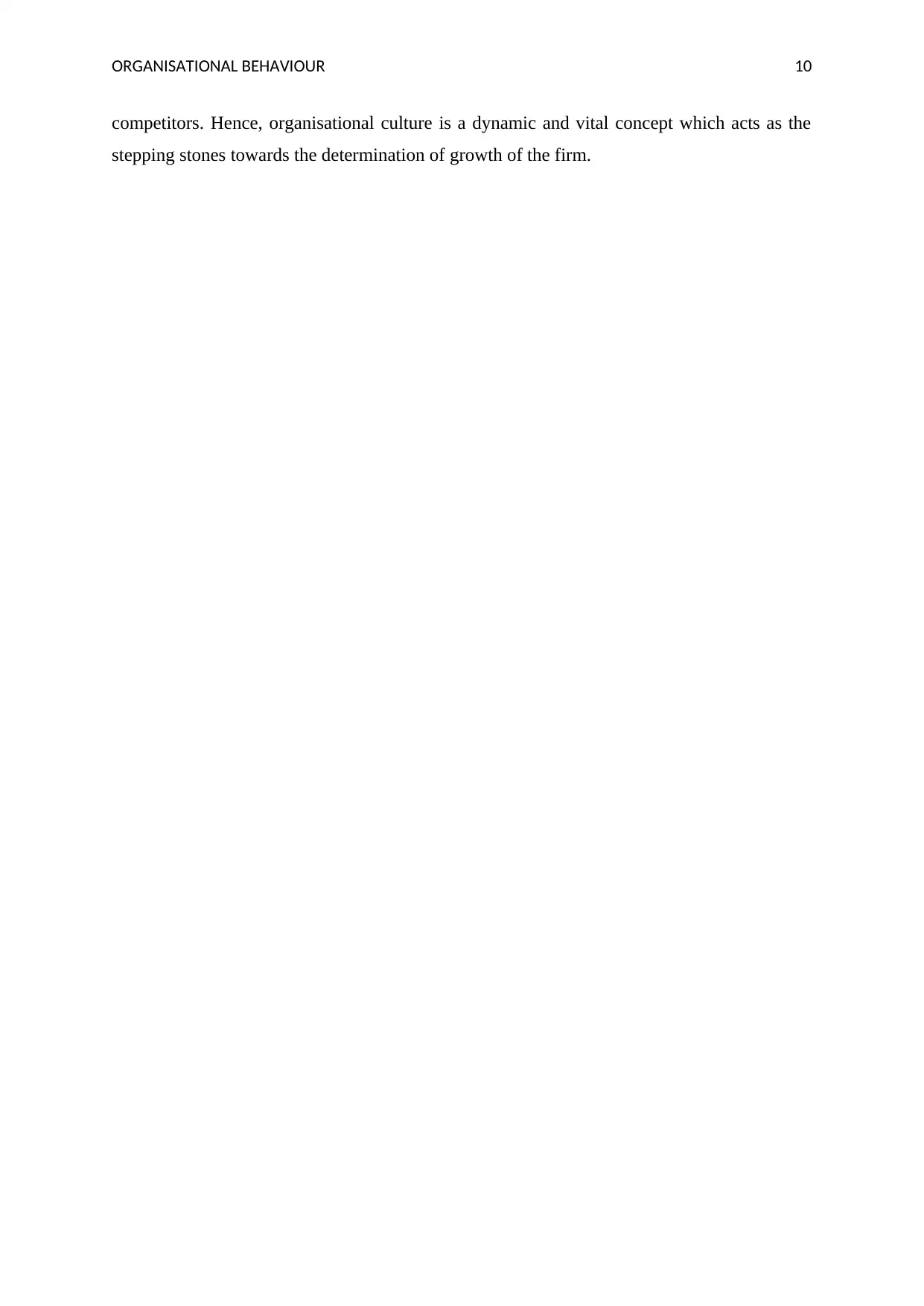
ORGANISATIONAL BEHAVIOUR 10
competitors. Hence, organisational culture is a dynamic and vital concept which acts as the
stepping stones towards the determination of growth of the firm.
competitors. Hence, organisational culture is a dynamic and vital concept which acts as the
stepping stones towards the determination of growth of the firm.

ORGANISATIONAL BEHAVIOUR 11
5. References
Alvesson, M., and Sveningsson, S. (2015) Changing organizational culture: Cultural change
work in progress. United Kingdom: Routledge.
Cerasoli, C.P., Nicklin, J.M., and Ford, M.T. (2014) Intrinsic motivation and extrinsic
incentives jointly predict performance: A 40-year meta-analysis. Psychological
bulletin, 140(4), p. 980.
Coleman, J. (2013) Six components of a great corporate culture. Harvard Business
Review, 5(6), p. 2013.
Glisson, C. (2015) The role of organizational culture and climate in innovation and
effectiveness. Human Service Organizations: Management, Leadership &
Governance, 39(4), pp. 245-250.
Groysberg, B., Lee, J., Price, J., and Cheng, J. (2018) The leader’s guide to corporate
culture. Harvard Business Review, 96(1), pp. 44-52.
Helms Mills, J.C., and Mills, A.J. (2017) Rules, Sense-making, Formative Contexts, and
Discourse in the Gendering of Organizational Culture. Insights and Research on the Study of
Gender and Intersectionality in International Airline Cultures (pp. 49-69). Emerald
Publishing Limited.
Hogan, S. J., and Coote, L. V. (2014) Organizational culture, innovation, and performance: A
test of Schein's model. Journal of Business Research, 67(8), pp. 1609-1621.
Hung, D.Y., Leidig, R., and Shelley, D.R. (2014) what’s in a setting: Influence of
organizational culture on provider adherence to clinical guidelines for treating tobacco
use. Health care management review, 39(2), pp. 154-163.
Katzenbach, J., Oelschlegel, C., and Thomas, J. (2016) 10 principles of organizational
culture. Strategy+ business, 82(spring), pp.1-7.
Kujala, J., Lehtimäki, H., and Pučėtaitė, R. (2016) Trust and distrust constructing unity and
fragmentation of organisational culture. Journal of business ethics, 139(4), pp.701-716.
5. References
Alvesson, M., and Sveningsson, S. (2015) Changing organizational culture: Cultural change
work in progress. United Kingdom: Routledge.
Cerasoli, C.P., Nicklin, J.M., and Ford, M.T. (2014) Intrinsic motivation and extrinsic
incentives jointly predict performance: A 40-year meta-analysis. Psychological
bulletin, 140(4), p. 980.
Coleman, J. (2013) Six components of a great corporate culture. Harvard Business
Review, 5(6), p. 2013.
Glisson, C. (2015) The role of organizational culture and climate in innovation and
effectiveness. Human Service Organizations: Management, Leadership &
Governance, 39(4), pp. 245-250.
Groysberg, B., Lee, J., Price, J., and Cheng, J. (2018) The leader’s guide to corporate
culture. Harvard Business Review, 96(1), pp. 44-52.
Helms Mills, J.C., and Mills, A.J. (2017) Rules, Sense-making, Formative Contexts, and
Discourse in the Gendering of Organizational Culture. Insights and Research on the Study of
Gender and Intersectionality in International Airline Cultures (pp. 49-69). Emerald
Publishing Limited.
Hogan, S. J., and Coote, L. V. (2014) Organizational culture, innovation, and performance: A
test of Schein's model. Journal of Business Research, 67(8), pp. 1609-1621.
Hung, D.Y., Leidig, R., and Shelley, D.R. (2014) what’s in a setting: Influence of
organizational culture on provider adherence to clinical guidelines for treating tobacco
use. Health care management review, 39(2), pp. 154-163.
Katzenbach, J., Oelschlegel, C., and Thomas, J. (2016) 10 principles of organizational
culture. Strategy+ business, 82(spring), pp.1-7.
Kujala, J., Lehtimäki, H., and Pučėtaitė, R. (2016) Trust and distrust constructing unity and
fragmentation of organisational culture. Journal of business ethics, 139(4), pp.701-716.
⊘ This is a preview!⊘
Do you want full access?
Subscribe today to unlock all pages.

Trusted by 1+ million students worldwide
1 out of 13